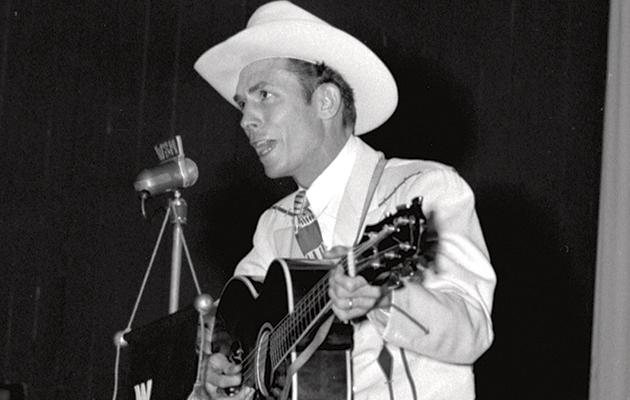“He was the greatest blues singer I ever heard,” says Bob Sullivan, the engineer who recorded Williams on the Louisiana Hayride country music show. “He could put more expression in a song than anyone else. Everything he sang was a blues.” His formative musical experiences were otherwise typical. Performances throughout Alabama with his backing band, The Drifting Cowboys, led to tentative early compositions.
Williams lost his first job a month before his 18th birthday by showing up “polluted” for his early morning stint at local station WFSA. Country veteran Roy Acuff, passing through town, told him: “You’ve got a million dollar voice, son, but a 10 cent brain.” By 21, he’d already had a stint drying out in a sanatorium. Nonetheless, he made steady progress. Signed to MGM, by 1947 he was starting to write and record some classics: “Honky Tonkin’”; “I Saw The Light”; “Never Again”. In August 1947 “Move It On Over” became his first hit on the Billboard country chart. It offered a glimpse of popular music’s future: “If you angle the beat slightly you have rock’n’roll,” claims Tom Petty.
“People talk about Elvis going down to Beale Street and all that bullshit,” adds Earle. “Elvis was emulating two people: Hank Williams and Wally Fowler from The Oak Ridge Boys. Hank’s music transcends country, and it did from jump street.”
By August 1948 Williams had graduated to an early morning radio show on KWKH in Shreveport and regular appearances on the high-profile Louisiana Hayride broadcast. It was a relatively settled time. He was married, had a secure income and plenty of gigging work. He was also sober. It was at Shreveport that his remarkable restyling of an old 1920s show tune, “Lovesick Blues”, started electrifying audiences. Video footage of only two Williams live performances exists, but those who witnessed him on stage recall an extraordinary, wired intensity. “It was incredible,” recalls Bob Sullivan. “I’ve recorded Elvis and Cash, but Hank Williams could walk out there with a four-piece country band and absolutely turn that crowd upside down. They just could not get enough of him. He was the greatest performer I’ve ever seen. Focused, sharp, fixed. On the quiet songs you could hear a pin drop. It was like a funeral.”


